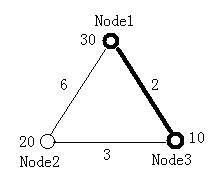Problem Description
For a tree, which nodes and edges are all weighted, the ratio of it is calculated according to the following equation.

Given a complete graph of n nodes with all nodes and edges weighted, your task is to find a tree, which is a sub-graph of the original graph, with m nodes and whose ratio is the smallest among all the trees of m nodes in the graph.

Given a complete graph of n nodes with all nodes and edges weighted, your task is to find a tree, which is a sub-graph of the original graph, with m nodes and whose ratio is the smallest among all the trees of m nodes in the graph.
Input
Input contains multiple test cases. The first line of each test case contains two integers n (2<=n<=15) and m (2<=m<=n), which stands for the number of nodes in the graph and the number of nodes in the minimal ratio tree. Two zeros end the input. The next line contains n numbers which stand for the weight of each node. The following n lines contain a diagonally symmetrical n×n connectivity matrix with each element shows the weight of the edge connecting one node with another. Of course, the diagonal will be all 0, since there is no edge connecting a node with itself.
All the weights of both nodes and edges (except for the ones on the diagonal of the matrix) are integers and in the range of [1, 100].
The figure below illustrates the first test case in sample input. Node 1 and Node 3 form the minimal ratio tree.

All the weights of both nodes and edges (except for the ones on the diagonal of the matrix) are integers and in the range of [1, 100].
The figure below illustrates the first test case in sample input. Node 1 and Node 3 form the minimal ratio tree.

Output
For each test case output one line contains a sequence of the m nodes which constructs the minimal ratio tree. Nodes should be arranged in ascending order. If there are several such sequences, pick the one which has the smallest node number; if there's a tie, look at the second smallest node number, etc. Please note that the nodes are numbered from 1 .
Sample Input
3 2
30 20 10
0 6 2
6 0 3
2 3 0
2 2
1 1
0 2
2 0
0 0
Sample Output
1 3
1 2
Source

1 #include <iostream> 2 #include <cstdio> 3 #include <cstring> 4 #define inf 0x3f3f3f3f 5 using namespace std; 6 int n,m; 7 int num[20]; 8 int map[20][20]; 9 int ans[20][20]; 10 int dis[20]; 11 bool mark[20]; 12 int DJ(int pm) 13 { 14 memset(dis,inf,sizeof(dis)); 15 memset(mark,false,sizeof(mark)); 16 for(int i=1;i<pm;i++) 17 { 18 dis[i]=ans[0][i]; 19 } 20 mark[0]=true; 21 int res=0; 22 int temp; 23 for(int i=1;i<pm;i++) 24 { 25 int Mi=inf; 26 for(int j=0;j<pm;j++) 27 { 28 if(!mark[j] && dis[j]<Mi) 29 { 30 Mi=dis[j]; 31 temp=j; 32 } 33 } 34 mark[temp]=true; 35 res+=Mi; 36 for(int j=0;j<pm;j++) 37 { 38 if(!mark[j] && dis[j]>ans[temp][j]) 39 { 40 dis[j]=ans[temp][j]; 41 } 42 } 43 } 44 return res; 45 } 46 int main() 47 { 48 while(~scanf("%d%d",&n,&m)) 49 { 50 if(n==0 && m==0) 51 { 52 break; 53 } 54 for(int i=0;i<n;i++) 55 { 56 scanf("%d",&num[i]); 57 } 58 59 for(int i=0;i<n;i++) 60 { 61 for(int j=0;j<n;j++) 62 { 63 scanf("%d",&map[i][j]); 64 } 65 } 66 double Minres=inf; 67 int respos; 68 for(int i=3;i<(1<<n);i++) 69 { 70 int nw=0; 71 int len=0; 72 int cnt=0; 73 int res[20]; 74 memset(res,-1,sizeof(res)); 75 while(i>=(1<<len)) 76 { 77 if(i&(1<<len)) 78 { 79 nw+=num[len]; 80 res[cnt++]=len; 81 } 82 len++; 83 } 84 if(cnt!=m) 85 { 86 continue; 87 } 88 memset(ans,inf,sizeof(ans)); 89 for(int j=0;j<cnt;j++) 90 { 91 for(int k=j+1;k<cnt;k++) 92 { 93 ans[j][k]=map[res[j]][res[k]]; 94 ans[k][j]=map[res[k]][res[j]]; 95 } 96 } 97 int rr=DJ(cnt); 98 if(rr*1.0/(nw*1.0)-Minres<-(1e-6)) 99 { 100 Minres=rr*1.0/(nw*1.0); 101 respos=i; 102 } 103 } 104 bool ff=false; 105 for(int i=0;i<n;i++) 106 { 107 if(respos&(1<<i)) 108 { 109 if(!ff) 110 { 111 ff=true; 112 printf("%d",i+1); 113 } 114 else 115 { 116 printf(" %d",i+1); 117 } 118 } 119 } 120 printf(" "); 121 } 122 return 0; 123 }
数据量的允许,使用二进制压缩的方法,枚举各种可能,每次都求一次最小生成树;
注意的地方是double 判<0( 小于0)使用高精度判断 例如判小于可以(a<b):a-b<-(1e-8)
否则会出现WA的情况
